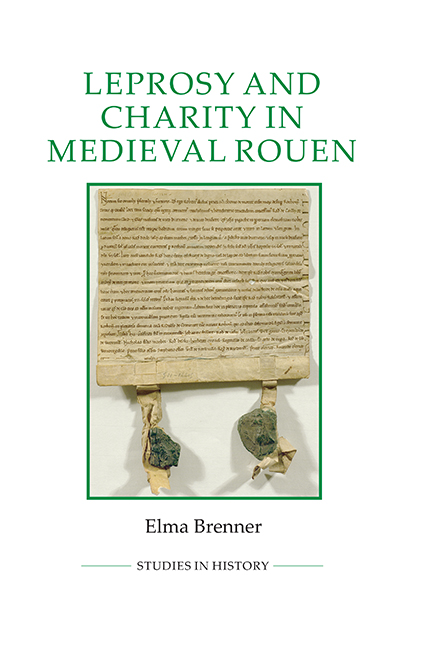Book contents
- Frontmatter
- Dedication
- Contents
- List of Illustrations
- Acknowledgements
- Abbreviations
- Introduction: Leprosy, Charity and Rouen
- 1 Rouen’s Principal Leper House: Mont-aux-Malades and Its Endowment
- 2 Charity and Community at Mont-aux-Malades
- 3 Rouen’s Other Leper Houses: Institutions, Gender and Status
- 4 Leprosy and the Medical World of Rouen
- 5 Leprosy and the Religious Culture of Rouen
- Conclusion
- Appendix 1 A Note on Sources
- Appendix 2 Charters and other Documents Relating to Leprosy in Rouen, c. 1100–c. 1500
- Bibliography
- Index
1 - Rouen’s Principal Leper House: Mont-aux-Malades and Its Endowment
Published online by Cambridge University Press: 07 May 2022
- Frontmatter
- Dedication
- Contents
- List of Illustrations
- Acknowledgements
- Abbreviations
- Introduction: Leprosy, Charity and Rouen
- 1 Rouen’s Principal Leper House: Mont-aux-Malades and Its Endowment
- 2 Charity and Community at Mont-aux-Malades
- 3 Rouen’s Other Leper Houses: Institutions, Gender and Status
- 4 Leprosy and the Medical World of Rouen
- 5 Leprosy and the Religious Culture of Rouen
- Conclusion
- Appendix 1 A Note on Sources
- Appendix 2 Charters and other Documents Relating to Leprosy in Rouen, c. 1100–c. 1500
- Bibliography
- Index
Summary
Although many of the institutions that provided for lepers in the Middle Ages have left little trace in the historical record, Rouen's most prominent leprosarium, Mont-aux-Malades, is known to us through its rich archive and architectural remains. The archive sheds light on not only the possessions and activities of the leprosarium, but also the charitable practices of Rouen's urban and ecclesiastical elites, particularly in the twelfth and thirteenth centuries. It complements the archives of Rouen's other religious institutions in this period, all of which reveal the social networks, religious culture and patterns of property tenure that shaped life in the medieval city.
Mont-aux-Malades was probably established in the first third of the twelfth century; it stood on a hill north-west of Rouen, in the area now known as Mont-Saint-Aignan. The church of Saint-Thomas, which served the leper community from the later twelfth century, is a functioning parish church today, while the nave of the earlier twelfth-century church of Saint- Jacques is also still standing. As seen elsewhere, such as the site of the leper house of St Nicholas at Harbledown, outside Canterbury, where today there are almshouses for the elderly, the Rouen site still has a welfare function: the maternity hospital Le Bellevedère is adjacent to the church of Saint-Thomas.
Mont-aux-Malades could well have originated as a group of lepers living together on a piece of available land, as did the leprosarium at Évreux, where the community gradually became institutionalised over the course of the twelfth century. By the mid-twelfth century, Mont-aux-Malades was organised as an Augustinian priory dedicated to St James. The leprosarium's subsequent development was due to the support of high-status lay and ecclesiastical patrons, above all that of members of the Anglo-Norman royal family. From the late twelfth century, following the rededication of Mont-aux-Malades to St Thomas Becket by Henry ii (king of England [1154–89] and duke of Normandy [1150–89]) in about 1174, Mont-aux-Malades became a focus of the charity of Rouen's burgess elite, a group that was becoming increasingly well-established and powerful at this time. The burgesses’ gifts made the leprosarium community a significant property-owner within the city of Rouen, and thus linked it to the commercial and political activities of urban society.
- Type
- Chapter
- Information
- Leprosy and Charity in Medieval Rouen , pp. 19 - 37Publisher: Boydell & BrewerPrint publication year: 2015



